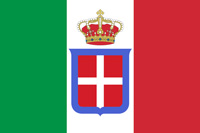World War I (1914-1918)

Seventh Battle of the Isonzo
The Seventh Battle of the Isonzo was fought from September 14-17, 1916 between the armies of the Kingdom of Italy and those of Austria-Hungary Austria-Hungary, often referred to as the Austro-Hungarian Empire, the Dual Monarchy, or Austria, was a constitutional monarchy and great power in Central Europe between 1867 and 1918. Austria-Hungary was one of the Central Powers in World War I, which began with an Austro-Hungarian war declaration on the Kingdom of Serbia on 28 July 1914. . It followed the Italian successes during the Trentino Offensive and the Sixth Battle of the Isonzo in the spring of 1916.
Austria-Hungary, often referred to as the Austro-Hungarian Empire, the Dual Monarchy, or Austria, was a constitutional monarchy and great power in Central Europe between 1867 and 1918. Austria-Hungary was one of the Central Powers in World War I, which began with an Austro-Hungarian war declaration on the Kingdom of Serbia on 28 July 1914. . It followed the Italian successes during the Trentino Offensive and the Sixth Battle of the Isonzo in the spring of 1916.
Battle
A short, sharp encounter fought from 14-17 September 1916, the Seventh Battle of the Isonzo saw Italian Chief of Staff Luigi Cadorna shift his focus from broad-based diversionary attacks to tightly focused initiatives directed at single targets. This latest Isonzo battle saw the Italian The Kingdom of Italy was a state that existed from 1861, when Victor Emmanuel II of Sardinia was proclaimed King of Italy, until 1946. The state resulted from a decades-long process, the Risorgimento, of consolidating the different states of the Italian Peninsula into a single state. That process was influenced by the Savoy-led Kingdom of Sardinia, which can be considered Italy's legal predecessor state. Third Army, with a large amount of artillery, attack on the Carso toward Nova Vas. Following the a successful first day, Nova Vas was assaulted on the second day with substantial artillery bombardments on German
The Kingdom of Italy was a state that existed from 1861, when Victor Emmanuel II of Sardinia was proclaimed King of Italy, until 1946. The state resulted from a decades-long process, the Risorgimento, of consolidating the different states of the Italian Peninsula into a single state. That process was influenced by the Savoy-led Kingdom of Sardinia, which can be considered Italy's legal predecessor state. Third Army, with a large amount of artillery, attack on the Carso toward Nova Vas. Following the a successful first day, Nova Vas was assaulted on the second day with substantial artillery bombardments on German The German Empire, also referred to as Imperial Germany, the Second Reich, as well as simply Germany, was the period of the German Reich from the unification of Germany in 1871 until the November Revolution in 1918, when the German Reich changed its form of government from a monarchy to a republic. During its 47 years of existence, the German Empire became the industrial, technological, and scientific giant of Europe. bunkers. Within minutes of the Italians ceasing fire, the Austro-Hungarian forces surrendered.
The German Empire, also referred to as Imperial Germany, the Second Reich, as well as simply Germany, was the period of the German Reich from the unification of Germany in 1871 until the November Revolution in 1918, when the German Reich changed its form of government from a monarchy to a republic. During its 47 years of existence, the German Empire became the industrial, technological, and scientific giant of Europe. bunkers. Within minutes of the Italians ceasing fire, the Austro-Hungarian forces surrendered.
Nevertheless Cadorna's continued offensives along the Soča (Isonzo) did succeed in wearing away at Austro-Hungarian resources, both in terms of manpower and in crucial artillery availability. As each battle proceeded the Italians' war of attrition seemed ever more likely to wear the Austro-Hungarians into defeat, short of assistance from their German allies.
The Eighth Battle of the Isonzo followed on 10 October 1916.
HISTORY

RESOURCES
This article uses material from the Wikipedia articles "World War", "World War I", and "Seventh Battle of the Isonzo", which is released under the Creative Commons Attribution-Share-Alike License 3.0.
© Stories Preschool. All Rights Reserved.










